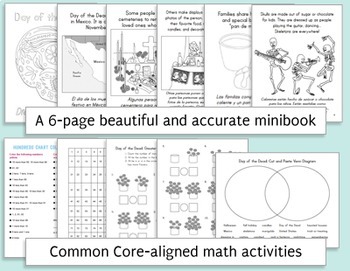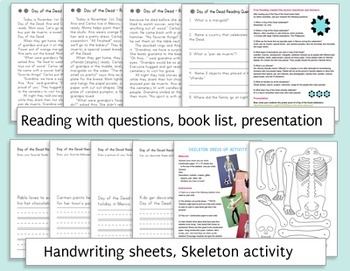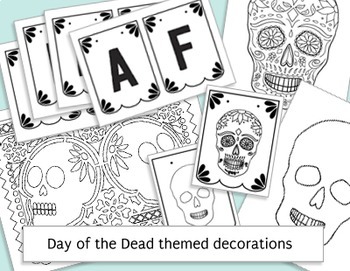Holidays around the World: Day of the Dead / Día de los Muertos ~ CC Aligned
- PDF
What educators are saying
Also included in
- This comprehensive Mexico unit in English is the single best resource for teaching about Mexico in your classroom! Combining activities and resources about Mexican history and geography, Hispanic culture, math, literacy, and art, this unit offers engaging lessons that present an authentic and well-rPrice $32.00Original Price $38.50Save $6.50
Description
As an alternative or an addition to Halloween activities, teachers can celebrate Day of the Dead with their students. This holiday also occurs at the end of October/beginning of November. Through a range of multicultural activities, crafts, and Common Core-aligned math and reading exercises, students can learn about a holiday celebrated by millions of people in Mexico, in other countries of Latin America, in the Philippines, in some countries Europe, and even in the US: Day of the Dead, or Día de los Muertos.
In this packet students will:
- Listen to stories about Day of the Dead, and then have a guided class discussion about the meanings of the holiday. Included in this section is: a book list, book summaries, and a list of discussion questions with key concepts defined
- Watch a colorful power point of Day of the Dead photographs, and identify themes and key components of the holiday
- Cut out and assemble a skeleton, and get creative dressing it up: a football player, musician, clown, ballerina, cowboy, or any unique character!
- Decorate the classroom with festive “calavera” (skull) bunting, posters, and papel picado. Instructions included!
- Make a bilingual (Spanish-English!) minibook about Day of the Dead and learn about how, where, and why it is celebrated
- Follow the instructions to color in numbered squares on a 100s chart, and discover the hidden, Day of the Dead picture (Answer key included)
- Practice “greater than, less than” counting marigolds (1-20), a typical flower used in Day of the Dead celebrations (Answer key included)
- Cut and paste ideas to create a Venn diagram comparing Day of the Dead with Halloween (Answer key included)
- Read a story (filled with high frequency vocabulary!) about children celebrating Day of the Dead with their family, and answer comprehension questions. Two versions of the story are included, at slightly different difficulty levels
- Practice handwriting skills while writing culturally-relevant phrases about Day of the Dead; then draw a picture that relates the holiday to their own celebrations and experiences
- In addition to the cultural guide for Day of the Dead and lots of printables, teachers also get a bonus coloring sheet and instructions to make 2 extra Day of the Dead crafts!
Also part of our MEGA Mexico Unit!!!
Teaching about Mexico? This best-selling product is also a part of our comprehensive Mexico Unit! A growing bundle, the unit is full of activities, resources, and games that use Mexico-related content to teach geography, ELA and literacy, math, art and social studies skills. From Mexico's landforms to Frida Kahlo's portraits, from the history of chocolate to today's lucha libre, this is one history, geography, and Hispanic culture packet you won't want to miss!






